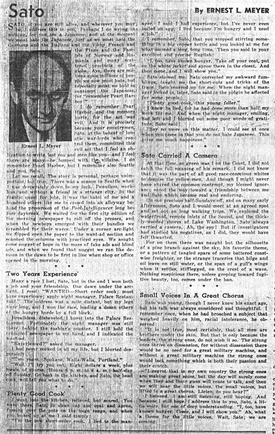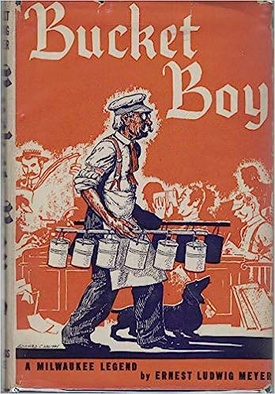In the period following the outbreak of the Pacific War, newspapers played a leading role in fomenting racial prejudice against Japanese Americans by reporting baseless accounts of espionage and fifth-column activity. West Coast columnists such as Harry McLemore beat the drum for mass removal of ethnic Japanese. Outside the West Coast, the distinguished columnist Walter Lippmann repeated rumors of contact between Japanese Americans and Japanese ships, while columnists from Damon Runyon to Westbrook Pegler penned negative pieces. In this hostile climate, one influential columnist, Ernest L. Meyer, stood up with understated courage, and expressed his dissent in tribute to an old friend.
It bears noting that Ernest Meyer was no stranger to victimization and ethnic stigmatization under wartime conditions. Born in Denver in 1892, he was the son of Georg (George) Meyer and his wife Anna, German immigrants who had come to the United States shortly before.
According to family legend, Georg had enlisted in the military, but had gotten into trouble with his superiors and was forced to flee for his life. During the following years, Georg migrated around the midwest, working for German-language newspapers in Lincoln, Winona, Chicago, Denver, Dubuque, and Appleton. Ultimately, he settled in Milwaukee as editor of the leading local German-language newspaper, the Germania. Georg later served as editor of another German-language journal, the Milwaukee Herold.
Ernest L. Meyer (the middle “L” for Lewis or Ludwig) grew up in Milwaukee. He was a senior at the University of Wisconsin and editor of the Wisconsin Literary Magazine in spring 1917, when the U. S. entered World War I. On his draft questionnaire he wrote: “I shall refuse . . . all combatant and noncombatant service.” Because he emphasized that he was refusing military service as a conscientious objector on political, not religious, grounds, the University expelled him and the government arrested him.
Meyer was incarcerated at Camp Taylor, where he met religious objectors of many creeds, many of German ancestry. Meyer recorded that though he faced no physical violence at Camp Taylor, many religious objectors were beaten, tied to bars of cells, or forced to stand in the sun until they collapsed. Furthermore, the “yellowbacks” had to use the same latrine as the soldiers with venereal disease.
In response, Meyer refused to wear his uniform, was placed under guard, put on trial three times, sent to Fort Leavenworth, and finally released after the Armistice (he was reinstated by the University of Wisconsin regents a decade later, but seems not to have finished his degree).
During the postwar years, Meyer broke into journalism, serving first as a writer-compositor for The Warden Herald in rural Washington state, then as a police reporter in Chicago. In the early 1920s, he joined the staff of the Capital Times, a liberal Madison, Wis., newspaper. Meyer first worked as managing editor, then was engaged to write a column, “Making Light of the Times.”
He also worked for the Socialist Party journal Socialist Leader in Milwaukee. During these years, he married and had two children. In 1934-5, Meyer accepted a position as columnist for The New York Post and moved to New York. His Post column, "As the Crow Flies,” covered political topics but also cultural news, including a visit to the architect Frank Lloyd Wright at Taliesin. During this period, Meyer settled in Westport, Connecticut.
Meyer resumed his pacifist activities over these years. In 1930, he published a book, Hey, Yellowbacks! The War Diary of a Conscientious Objector, about his wartime experiences, and about the humiliations he underwent at Camp Taylor and Camp Sherman. He likewise produced antiwar articles such as “If War Should Come and I'd Refuse” for The Christian Century in 1932 and “Pacifists in the Next War” in The North American Review in 1934.
He joined the Keep America out of War Committee, and in March 1938 attended the organization’s rally at New York’s Hippodrome. Even after war broke out in Europe, he remained opposed to U.S. intervention in the conflict.
All the same, Meyer was increasingly uneasy about the rise of Nazi Germany and Soviet Russia. He had attended a Hitler rally in pre-Third Reich Berlin in 1932, and initially dismissed the Nazi movement as absurd. In 1938, speaking at an anti-Nazi rally in New York, he confessed his error and warned of the peril of Nazism.
Despite his ardent advocacy of civil rights, he expressed doubt as to whether the American Nazi organization German American Bund should be permitted to hold public rallies, and worried that Nazis might seize power in America. He likewise denounced the show trials in the Soviet Union, supported the inquiry committee led by philosopher John Dewey and joined the American Committee for the Defense of Leon Trotsky.
In early 1941, Meyer left the New York Post. He publicly charged that he had been pressured by the Post editors to abandon political topics, because would not adopt the pro-war line of the newspaper’s new ownership. When he refused, his columns were censored and “liquidated.”
After being dismissed by the Post, Meyer began writing a weekly column, “The Man in the Alcove,” for the Wisconsin-based newspaper The Progressive. In the aftermath of Pearl Harbor and the U.S. entry into war, Meyer formally abandoned his antiwar stance. Like Socialist Party leader Norman Thomas, he faced harsh criticism over his prewar pacifism.
Again like Thomas, Meyer remained attentive to the rights of minorities. In the January 17, 1942 issue of the Progressive, he published a remarkable article, titled “Sato.” The article started with Meyer’s facetious comment that he might be doing wrong by addressing himself to a Japanese man, since he knew that he was supposed to hate all Japanese, like all Germans, Italians, Vichy French, and countless others—but especially to hate Japanese and to “remember Pearl Harbor.”
Meyer noted that he DID remember Pearl Harbor, but as an evil act perpetrated on the orders of “lunatic war-lords,” and one of which Sato and many others like him were victims.
The author then proceeded to tell a story of a time when he was in Seattle and down on his luck—penniless, jobless, and friendless in a strange city. He saw a newspaper ad for a short-order cook at a local restaurant, and raced immediately to apply. On being asked about his experience, he replied that he had cooked for two years. He was hired and sent to the kitchen to see Sato, the head cook.
He then blurted out the truth that he had never cooked, but had lied because he was hungry and needed a job. Sato had replied, with precise English, “I too, have known hunger…Come, and I will show you.” Sato proceeded to train him in cooking, do much of his work for him, cover up his errors, and praise him (in affected pidgin English) to the night manager.
Sato pooh-poohed the narrator’s gratitude, stating simply, “I could see at once when you came in that you do not hate Japanese.” The two became close friends, and would take Sunday nature walks together, during which Sato, a skilled amateur cameraman, took photos.
Once when they were discussing racial intolerance, Sato complained of strongmen who inflamed hostilities to keep control over others. “I regret that in my own country the strong ones are making great noise, but the day will surely come when they and their guns will cease to talk, and we will hear the little voices, the small voices, but lifted in a great chorus, Listen, do you hear?”
Meyer closed by saying that he was still listening and still hoping. “And because I still hope, I address this to you, Sato, a little voice, but one of deep understanding. ‘I too, have known hunger. Come, and I will show you.’ Ah, what a theme for the little voices. Wait, Sato; we are coming.”
Meyer’s column drew an extended response from a Nisei reader, identified as “J.T.O.” (likely the journalist Joseph T. “ Joe” Oyama). “J.T.O.” said that he was moved to tears by Meyer’s column, that “Sato” could have been his father or the father of many readers of all groups. Now, however, the generation of the “Satos” had aged. With the declaration of war, the “Satos” and their children faced harsh prejudice, with “Satos” next door being sent to concentration camps and thousands losing their jobs. “J.T.O.” concluded that he was hoping to organize efforts to combat prejudice and violence against Japanese Americans and to avert any disloyal activities, but that the community was facing mass unemployment and hunger.
“I am just as anxious to weed out any disloyal element among us as [conservative Congressman] Martin Dies. I want to do it for our own safety. A few overt acts in the state will bring down the wrath of the population on us. Anything is magnified a hundred times. Already Sato and the sons and grandsons of Sato are feeling the encirclement of hostility. What tomorrow will bring, God only knows.”
Meyer published long extracts from the letter in his February 14, 1942 column. In a headnote, he added, “In view of the wholesale arrests and deportation of thousands of Japanese from the Pacific Coast area, the letter is, I think of extreme and timely interest.”
It is unclear how Mayer arrived at this foresightful description—which appeared in an issue dated five days before Executive Order 9066 was issued—unless he meant the Justice Department orders from January 1942 that created protected areas and excluded enemy aliens from them.
While Meyer seems not to have reported or editorialized further on the mass confinement of Japanese Americans during 1942, he did make statements soon after, albeit in more indirect fashion. In 1943 he published an essay, “When the Aliens Left,” in Common Ground, the New York-based pro-immigrant quarterly. In it he imagined, Twilight Zone-fashion, that conservative columnist Westbrook Pegler, who had been calling for “America for the Americans,” got his wish from a genie that all aliens be exiled from America. Pegler agreed that they should take all their creations with them because “they have fashioned nothing but dissent and plots and labor racketeering and radical heresies and sins and sabotage.”
Yet when the aliens vanished, so did much of existing America. Gone were “whole cities of skyscrapers and subways and railroads and mills and marts wrought by the sinews of many aliens from the four quarters of the world when the call went out that America needed immigrants to make America great.” What followed, Pegler discovered, was “a great and strange silence.”
During the years after World War II, Meyer worked as telegraph editor of New York’s Daily News. In 1947 he published Bucket Boy, a well-reviewed memoir of late-nineteenth-century German-American Milwaukee and his early newspaper days. Meyer died in New York in February 1952.
His son Karl E. Meyer followed in his footsteps when he was hired in 1952 by the New York Times. After serving with the Washington Post and other journals, in 1979 the younger Meyer was named senior writer for foreign affairs by the Times, a position he held until his retirement in 1998.
Karl Meyer would pay warm tribute to his father in Pundits, Poets, and Wits, his anthology of American column writing. “Sato: A Letter to a Japanese American” would be republished in the 2009 book Democracy in Print, a centenary anthology of outstanding writing from The Progressive.
Ernest L. Meyer, a young American of German ancestry who refused to fight, went through a horrific experience during World War I. It clearly helped shape his later dedication to pacifism and civil rights for minorities.
His tale of friendship with “Sato” revealed his understanding of the human dimension of Japanese American life, and the prejudice that community members faced. The lessons he learned inspired him to express his quiet solidarity in their time of peril.
© 2023 Greg Robinson








